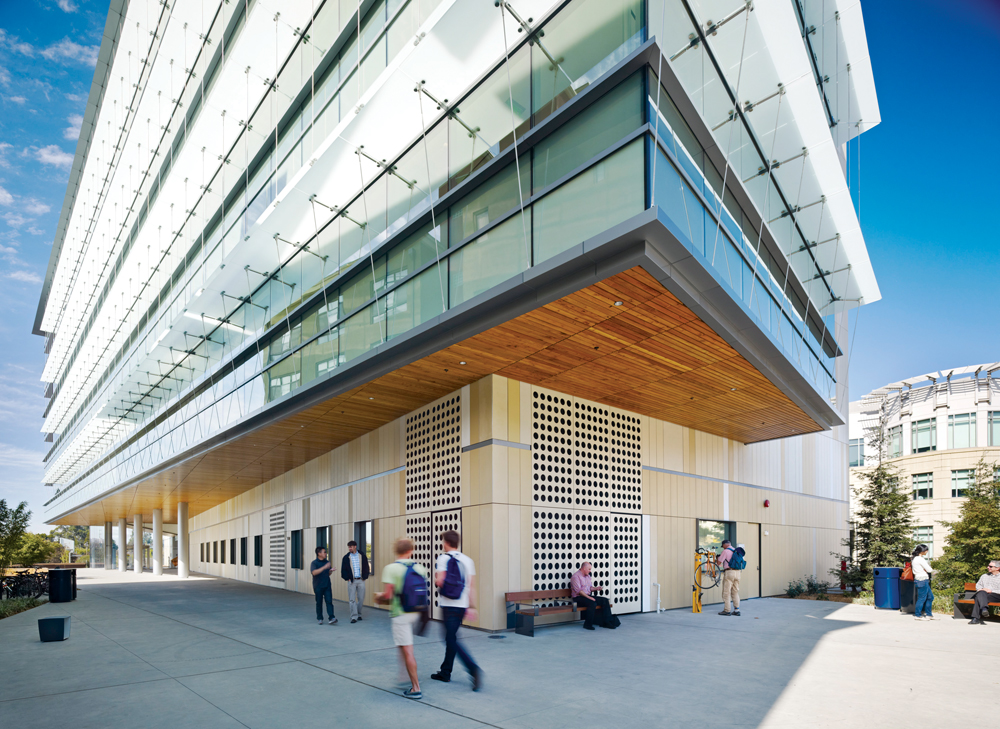After an era of biology-oriented spending—largely driven by Big Pharma and government concerns about bioterrorism—climate change is reshaping priorities in science and technology construction. “Engineering and chemistry funding are going up now, as is energy research, which seems to continue to get federal funding,” says Andy Vazzano, FAIA, LEED AP, Science and Technology Practice Leader at SmithGroupJJR. “Meanwhile, the sequester and budget cuts are having a negative impact on NIH funding for biomedical research.”
The focus on human health hasn’t totally faded, with many research universities still building new labs—especially those that tie research to clinical practice. “Anything that begins with ‘trans’ or ‘inter’ is still a major trend,” says Ryan Abbott, Science and Technology Project Director at Sundt Construction and a BD+C “40 Under 40” honoree (Class of 2012). “Translational, interdisciplinary. Modern science is a team sport.”
TOP S&T SECTOR ARCHITECTURE FIRMS
2012 S+T Revenue ($)1 HDR Architecture $91,252,0002 Perkins+Will $48,373,5683 HOK $38,347,0004 Stantec $33,111,4695 SmithGroupJJR $26,400,0006 Flad Architects $21,480,0007 Payette $18,434,0298 ZGF Architects $16,214,2679 EwingCole $11,000,00010 FKP Architects $10,250,000
TOP S&T SECTOR ENGINEERING FIRMS
2012 S+T Revenue ($)1 Affiliated Engineers $19,824,0002 Middough $13,900,0003 URS Corp. $11,772,1244 Bard, Rao + Athanas Consulting Engineers $10,500,0005 RMF Engineering Design $9,200,0006 Vanderweil Engineers $7,851,9007 Paulus, Sokolowski and Sartor $7,500,0008 WSP USA $5,772,0959 Science Applications International Corp. $3,103,15210 STV $2,937,000
TOP S&T SECTOR CONSTRUCTION FIRMS
2012 S+T Revenue ($)1 Skanska USA $376,717,4742 DPR Construction $298,563,6423 Suffolk Construction $290,560,3074 Manhattan Construction $199,444,0005 Whiting-Turner Contracting Co., The $193,160,4256 JE Dunn Construction $184,799,0517 Clark Group $174,348,8048 Turner Corporation, The $157,490,0009 Structure Tone $143,798,00010 Consigli Construction $74,568,263
Though the purpose-built med school building is the iconic face of S+T, adaptive reuse is getting a second look for advantages in cost and speed. Many clients are also seeking higher levels of green; LEED Platinum, once thought impossible for labs, is no longer unique, and clients are increasingly eyeing net-zero.
In addition, look for public/private partnerships to assume a greater role, even in the rarefied atmosphere of the Ivy League. Harvard, for instance, has rethought its Allston science campus during a recession hiatus. When the site cranks up again next year, the program will include a 36-acre, privately developed “enterprise research campus” for related companies in pharma, biotech, and venture capital.
Read BD+C's full Giants 300 Report
Related Stories
| Dec 13, 2010
Energy efficiency No. 1 priority for commercial office tenants
Green building initiatives are a key influencer when tenants decide to sign a commercial real estate lease, according to a survey by GE Capital Real Estate. The survey, which was conducted over the past year and included more than 2,220 office tenants in the U.S., Canada, France, Germany, Sweden, the UK, Spain, and Japan, shows that energy efficiency remains the No. 1 priority in most countries. Also ranking near the top: waste reduction programs and indoor air.
| Dec 7, 2010
Are green building RFPs more important than contracts?
The Request for Proposal (RFP) process is key to managing a successful LEED project, according to Green Building Law Update. While most people think a contract is the key element to a successful construction project, successfully managing a LEED project requires a clear RFP that addresses many of the problems that can lead to litigation.
| Dec 7, 2010
Blue is the future of green design
Blue design creates places that are not just neutral, but actually add back to the world and is the future of sustainable design and architecture, according to an interview with Paul Eagle, managing director of Perkins+Will, New York; and Janice Barnes, principal at the firm and global discipline leader for planning and strategies.
| Dec 7, 2010
Green building thrives in shaky economy
Green building’s momentum hasn’t been stopped by the economic recession and will keep speeding through the recovery, while at the same time building owners are looking to go green more for economic reasons than environmental ones. Green building has grown 50% in the past two years; total construction starts have shrunk 26% over the same time period, according to “Green Outlook 2011” report. The green-building sector is expected to nearly triple by 2015, representing as much as $145 billion in new construction activity.
| Dec 7, 2010
USGBC: Wood-certification benchmarks fail to pass
The proposed Forest Certification Benchmark to determine when wood-certification groups would have their certification qualify for points in the LEED rating systemdid not pass the USGBC member ballot. As a result, the Certified Wood credit in LEED will remain as it is currently written. To date, only wood certified by the Forest Stewardship Council qualifies for a point in the LEED, while other organizations, such as the Sustainable Forestry Initiative, the Canadian Standards Association, and the American Tree Farm System, are excluded.
| Dec 7, 2010
Prospects for multifamily sector improve greatly
The multifamily sector is showing signs of a real recovery, with nearly 22,000 new apartment units delivered to the market. Net absorption in the third quarter surged by 94,000 units, dropping the national vacancy rate from 7.8% to 7.1%, one of the largest quarterly drops on record, and rents increased for the second quarter in a row.
| Dec 7, 2010
Hot rumor: Norman Foster designing Apple’s new campus
Lord Norman Foster, reportedly has been selected to design Apple’s new campus in Cupertino, Calif. If the news is true, Foster is a good match for Apple say experts. Foster built his celebrity by marrying big gestures to technological wizardry. And, unlike some starchitects, he has glommed onto the environmental revolution—something Apple has made a point of embracing, too.
| Dec 7, 2010
10 megacities of the near future
With Beijing, Shanghai, and Mumbai already on the global radar, where can the next wave of construction be found? Far beyond China, India, and even Brazil it’s predicted. The world’s next future megacities could include Istanbul, Turkey; Ho Chi Minh City, Vietnam; and Khartoum, Sudan, among others. Read about these emerging and little-known behemoths.








